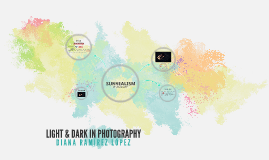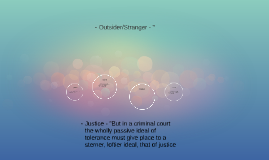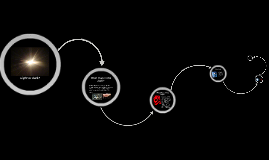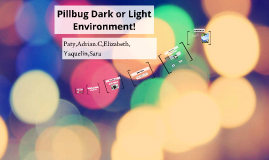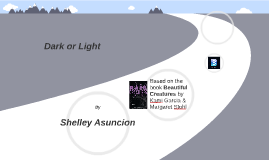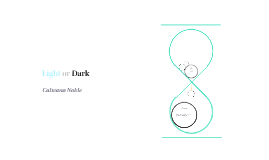Light/dark
Transcript: the dark seeing the dark Light is one of those things that we are sort of born understanding. However much science teaches us about photons and radiation wave lengths we still don't change the fundamental meaning of light. We don't bring this meaning to words. We can use it freely in our speech as an idiom, compare it to things, categorize things as light, etc. Even in the times of Ancient Greece, when Oedipus Rex was written by Sophocles, people understood the rules of light. We know The opposite of light is dark Light comes from a source We need light to see The language in Oedipus is poetic, because even though it's a play the medium was still developing. Words were still for free use. There weren't as many rules. Because of the balance of restrictions writers like Sophocles could use different language. What does it mean to say "Thebes [is a] sunwhipped city"? Why are the gods and their overwhelming power and majesty associated with strong light, meaning why should the "gods descend, [coming] with blinding torches"? Why are gods in their divinity symbolized by the inability for mortals to see their gods in their true form? "Let it come! However base my birth, I must know about it." The light we know comes from the sun. Almost all the energy in the world comes from the sun. When we think of light, because we naturally affiliate light with the sun and sun with energy, we feel like light makes us feel beetter. That's why some people have better moods when it's sunny outside. In poetry darkness is associated with evil and uncertainty. Saying a setting is dark, in place or with zeitgeist, makes people think of opposition pairs like good and bad, sickness and health, and other things that don't have anything to do with photons. Light has this kind of power over us, it can control our mind, because it's so familiar in our heads. We understand light enough it becomes an idiom. "O Oedipus, most royal one!/The great door that expelled you to the light/gave at night--ah, gave night to your glory:/As to the father, to the fathering son." In this case light is the fame and night is infamy and scandal. Oedipus has fallen from up where it was light rapidly to the dark deep below. "A blind man, Who has his eyes now, a penniless man, who is rich now; And he will go tapping the strange earth with his staff To the children with whom he lives now he will be Brother and father-- the very same; to her Who bore him, son and husband--the very same Who came to his father's bed, wet with his father's blood." ~Teiresias, p25 Every one of us has this addiction to understanding and certainty. We need light to see everything properly. We find comfort in certainty, like everything is clear and in control. Our attention might show us the unknown, and our instinct is to find the answers, whether the answers will help us or not. In Oedipus Rex king Oedipus only has the duty of being king. Whatever clairvoyant Teiresias was trying to say by telling Oedipus that with the truth comes the answer, Oedipus wouldn't have been blind and he'd still be king. He had this need for certainty feeding his passion. His wife was trying to get him to be realistic, mostly because of her own fear of the truth. This fear of the unknown can cancel out the need for things to be known. These forces are related and could be inverses of each other. There is warmth in knowing the whole truth and there is warmth in believing you already do. And one more thing... Krishna Anand E 167 Ms Weiss Theme and motif poster "The next full moon, a grace to your gentle shade," sings the Strophe in Ode III. Light and dark each influence certain feelings on you. In this case both are parallels, light being stronger but still graceful while the dim being daintier. There are different kinds of light and dark because of the mood and the way we percieve the setting. Sunny may mean optimistic or torturous. We have given light and dark all these different meanings. Merriam-Webster's first definition of light as "something that makes sight possible." We cannot know something without seeing it. With light comes focus. In Oedipus Rex, Oedipus the king looks for the light on his past. The past to him is a mystery. All he has is the prophecy, the drunken message, and Iocaste's experience with the oracle. He needs this light to see clearly, and light to him helps him in his search. Finding the light is finding the truth. Thank you for your attention! "The [oracle] of Delphi... he spoke of other things... that I should lie with my own mother, breed children from whom all men would turn their eyes, and that I should be my father's murderer." ~Oedipus, describing the prophecy (p42) Our own definitions Light is the Source the warmth of light Direct Rays of Light Light can control our attention. In the real world we would notice things better if they were lit up. Oedipus's attention draws him from worrying about his country during the plague to blinding himself in self-protecting passion. If we






